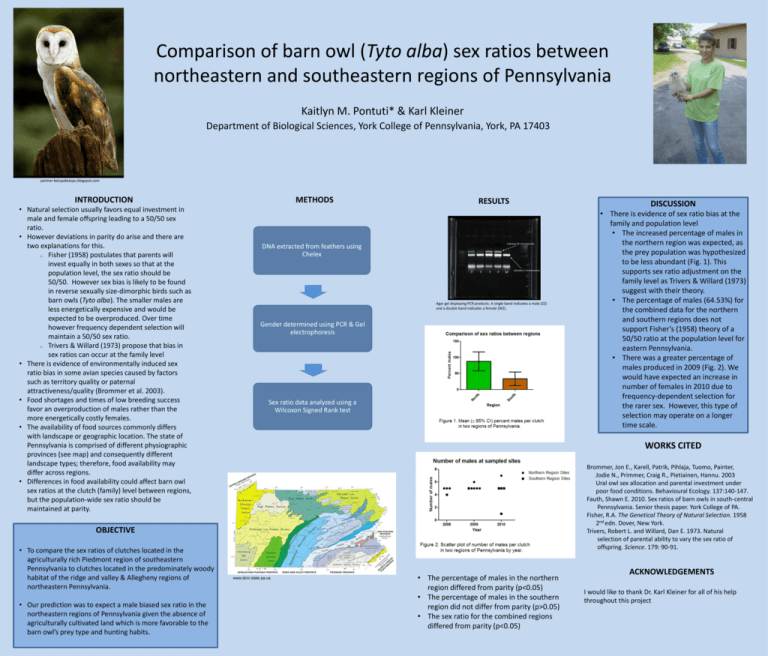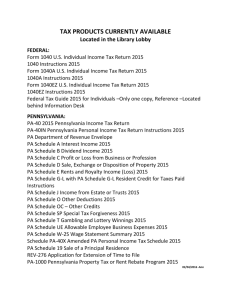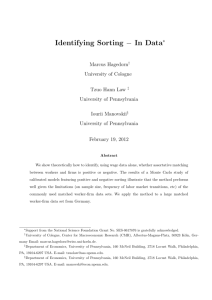Pontuti - York College of Pennsylvania
advertisement

Comparison of barn owl (Tyto alba) sex ratios between northeastern and southeastern regions of Pennsylvania Kaitlyn M. Pontuti* & Karl Kleiner Department of Biological Sciences, York College of Pennsylvania, York, PA 17403 partner-ketupaketupu.blogspot.com INTRODUCTION • Natural selection usually favors equal investment in male and female offspring leading to a 50/50 sex ratio. • However deviations in parity do arise and there are two explanations for this. o Fisher (1958) postulates that parents will invest equally in both sexes so that at the population level, the sex ratio should be 50/50. However sex bias is likely to be found in reverse sexually size-dimorphic birds such as barn owls (Tyto alba). The smaller males are less energetically expensive and would be expected to be overproduced. Over time however frequency dependent selection will maintain a 50/50 sex ratio. o Trivers & Willard (1973) propose that bias in sex ratios can occur at the family level • There is evidence of environmentally induced sex ratio bias in some avian species caused by factors such as territory quality or paternal attractiveness/quality (Brommer et al. 2003). • Food shortages and times of low breeding success favor an overproduction of males rather than the more energetically costly females. • The availability of food sources commonly differs with landscape or geographic location. The state of Pennsylvania is comprised of different physiographic provinces (see map) and consequently different landscape types; therefore, food availability may differ across regions. • Differences in food availability could affect barn owl sex ratios at the clutch (family) level between regions, but the population-wide sex ratio should be maintained at parity. METHODS RESULTS DISCUSSION indicates W chromosome DNA extracted from feathers using Chelex F F F F M indicates Z chromosome Agar gel displaying PCR products. A single band indicates a male (ZZ) and a double band indicates a female (WZ). Gender determined using PCR & Gel electrophoresis Sex ratio data analyzed using a Wilcoxon Signed Rank test WORKS CITED Brommer, Jon E., Karell, Patrik, Pihlaja, Tuomo, Painter, Jodie N., Primmer, Craig R., Pietiainen, Hannu. 2003 Ural owl sex allocation and parental investment under poor food conditions. Behavioural Ecology. 137:140-147. Fauth, Shawn E. 2010. Sex ratios of barn owls in south-central Pennsylvania. Senior thesis paper. York College of PA. Fisher, R.A. The Genetical Theory of Natural Selection. 1958 2nd edn. Dover, New York. Trivers, Robert L. and Willard, Dan E. 1973. Natural selection of parental ability to vary the sex ratio of offspring. Science. 179: 90-91. OBJECTIVE • To compare the sex ratios of clutches located in the agriculturally rich Piedmont region of southeastern Pennsylvania to clutches located in the predominately woody habitat of the ridge and valley & Allegheny regions of northeastern Pennsylvania. • Our prediction was to expect a male biased sex ratio in the northeastern regions of Pennsylvania given the absence of agriculturally cultivated land which is more favorable to the barn owl’s prey type and hunting habits. • There is evidence of sex ratio bias at the family and population level • The increased percentage of males in the northern region was expected, as the prey population was hypothesized to be less abundant (Fig. 1). This supports sex ratio adjustment on the family level as Trivers & Willard (1973) suggest with their theory. • The percentage of males (64.53%) for the combined data for the northern and southern regions does not support Fisher’s (1958) theory of a 50/50 ratio at the population level for eastern Pennsylvania. • There was a greater percentage of males produced in 2009 (Fig. 2). We would have expected an increase in number of females in 2010 due to frequency-dependent selection for the rarer sex. However, this type of selection may operate on a longer time scale. www.dcnr.state.pa.us • The percentage of males in the northern region differed from parity (p<0.05) • The percentage of males in the southern region did not differ from parity (p>0.05) • The sex ratio for the combined regions differed from parity (p<0.05) ACKNOWLEDGEMENTS I would like to thank Dr. Karl Kleiner for all of his help throughout this project





